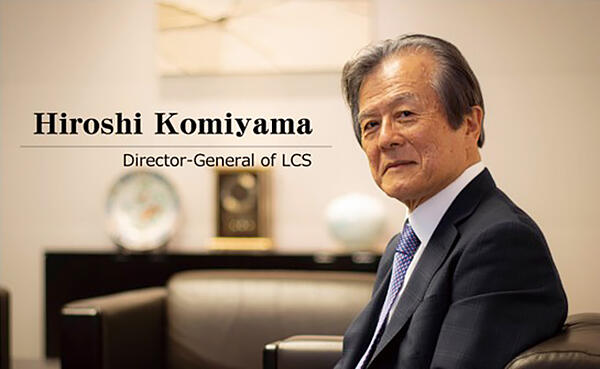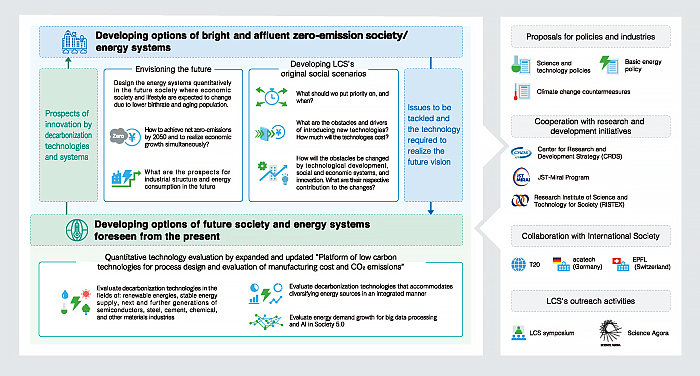In recent years, abnormal weather events and resulting natural disasters have become more frequent. Climate change is thought to be a cause of this unusual weather, and initiatives to address it while also aiming for sustainable development are underway. JST News' new series "How Can We Make It Happen? A Bright and Affluent Zero-Emission Society" forms a story narrated by a young employee of a trading company, Yutaka Minakawa. The series will - through describing and interpreting proposal papers published by the Center for Low Carbon Society Strategy (LCS) - showcase the latest trends across a wide range of industries. The first installment of the series hears from LCS Director-General Hiroshi Komiyama about how the path to Japan's revitalization begins with decarbonization.

Director-General of LCS
Breaking away from both empty shopping streets in regional cities and overconcentration in Tokyo
Department manager: Hey Minakawa, do you have a moment? They've started accepting new members of the new project evaluation team. The board members are eager to keep up with the global decarbonization business, and they wanted to hear from younger members of the company. You'll be able to show your strength.
I'll introduce you to someone I know very well, and we are relying on you to come up with some good ideas.
Minakawa: I'm on it.
- One month later -
Minakawa: It's nice to meet you. My name is Yutaka Minakawa. Thank you for your time today.
Komiyama: I hear that you want advice for new business plans for a trading company. Could you give share your opinions first please?
Minakawa: In recent years, the effects of global warming have become more and more visible and severe. Social contribution initiatives such as the SDGs and ESG investment are increasing rapidly, and we want to make decarbonization a core part of our business. However, Japan's society is still in an unstable situation, with a declining birthrate and aging population, a sluggish economy, and unstable international conditions. I'm concerned that people still have not fully grasped how important decarbonization is. There's a popular image that decarbonization means making a wide range of sacrifices, both in daily life and in business.
Komiyama: Yes, the declining birthrate and aging population is a massive issue. The overall population as well as the ratio of the working-age population continue to dwindle. Even more than the decreasing population, my concern is that there being fewer people means society will become less lively. I believe that it is important to create a society where young people do not have to worry about having and raising children.
Minakawa: It's interesting you should talk about the liveliness of society. When I traveled to Africa, I was stunned that regional towns had so much energy to them, it was off the scale compared to Japan. You would expect that Japanese regional cities are much wealthier, but there are many vacant stores on the main shopping street, I was shocked at the enormous difference in energy levels.
Komiyama: That's a really important point. I feel that Japan's urbanization has gone too far, and it isn't creating much happiness for anyone. I believe that breaking away from overconcentration in Tokyo and revitalizing the regions is a precondition to enriching people's lifestyles.
Local production of energy for local consumption: Harnessing community resources to create new industries
Minakawa: That makes sense to me. But how is revitalizing the regions related to decarbonization?
Komiyama: It's massively related. Why do you think people only gather in big cities in the first place?
Minakawa: I guess it's because there isn't much work in the regions, but there is in the big cities. I'm from a regional area myself, but now I am working for a company in Tokyo.
Komiyama: Exactly.
The first mission is to create employment in regional areas.
But how?
This is where the connection to decarbonization comes in. Renewable energies such as solar, wind, and biomass are the mainstay of decarbonization.
And, in fact, renewable energy is not a good fit for overconcentrated urbanism.
Do you know why?
Minakawa: You need large land areas to achieve high power outputs, so power plants have to be located well away from urban areas. The further a power station is from the city, the greater the transmission loss, and the capacity of powerlines to big cities is lacking.
Komiyama: So, what do you think we should do?
Minakawa: Revitalize regional economies so that energy can be produced and consumed locally!
Komiyama: You got it. Solar, wind, hydro, and geothermal power can all be produced in rural areas. On Tanegashima Island in Kagoshima Prefecture, where I have worked, junior high and high school students are involved in the design and visioning of the local energy system. They've now even got the mayor involved in serious discussions about the future of energy on the island. Then there's biomass. Japan is rich in forest resources, but they are not being utilized enough. Wood is a carbon-neutral fuel, and is also a raw material in construction and industrial products. Looking ahead, more and more high-rise buildings will soon be made out of wood instead of reinforced concrete.
● LCS's Approach

(Source: LCS website https://www.jst.go.jp/lcs/en/about/concept/introduction.html)
LCS' influence on society also includes business opportunities from research proposal papers
Minakawa: Biofuels absorb carbon dioxide (CO2) through photosynthesis, which, subtracted from the emissions created when burned, means net zero emissions. I understand wooden architecture, but I can't really think of what industrial products you mean.
Komiyama: Wood is made up of two main substances, cellulose and lignin, but lignin has never been available for anything. It can now be extracted and used as a raw material for biodegradable plastics. In addition, cedar, which is plentiful in Japan's forests, works really well in this process. The combination of new science and technology plus natural resources makes Japan's rural areas a genuine treasure trove.
Minakawa: I see. It's about creating a regional business ecosystem centered on forestry resources and the renewable energy industry. Creating interlinked employment and industries like that would reimagine and reinvigorate regional cities as hubs for the decarbonization business. Our company would love to help! You mentioned people's happiness, So how can we connect our personal lives with the reduction of CO2 emissions? CO2 emissions reduction is often associated with the image of being forced to endure.
Komiyama: The mission of LCS is "a bright and affluent zero-emission society," so we are thinking about scenarios that do not demand sacrifices on the individual level either. CO2 emissions from households are of course also covered by our analysis. For more details, I recommend you talk to LCS Visiting Researcher Tomoko Iwata. She can tell you about choosing houses and home appliances that do not emit CO2, and much more.
Minakawa: That's interesting. Please tell me more about LCS initiatives overall.
Komiyama: At LCS, we have what we call "Extended Input-Output Tables." We use them to conduct inclusive analysis of the impact from a variety of decarbonization initiatives on society overall. For example, let's look at solar power generation. We evaluate everything from the materialistic, economic, and social ripple effects involved in the processes from panel manufacturing to scrapping, to the changes in power generation costs through technological advancements, modeling realistic scenarios by which we can reach zero CO2 emissions by 2050. Even taking into account global companies that have made net-zero emissions declarations, I believe that we are the only organization in the world whose initiatives go this far.
Minakawa: There are just so many ways of approaching decarbonization! I imagine that analyzing LCS proposal papers will reveal many business opportunities I haven't thought of. Thank you for your valuable time today.
*This is a fictional narrative based on an interview.
(Text and photos by Tomokazu Fukui)





